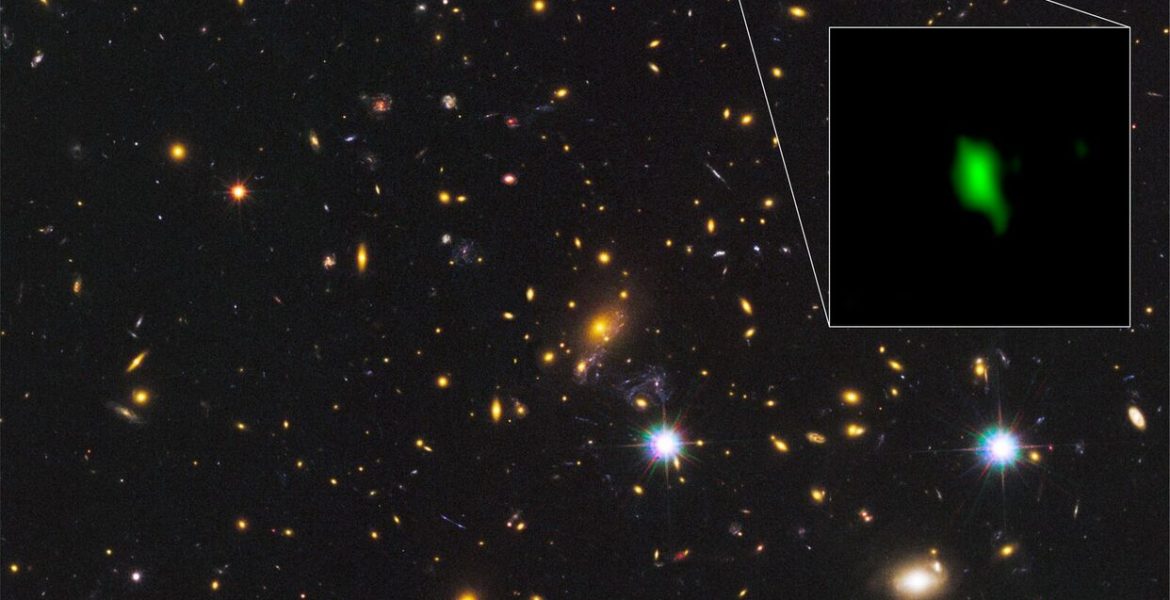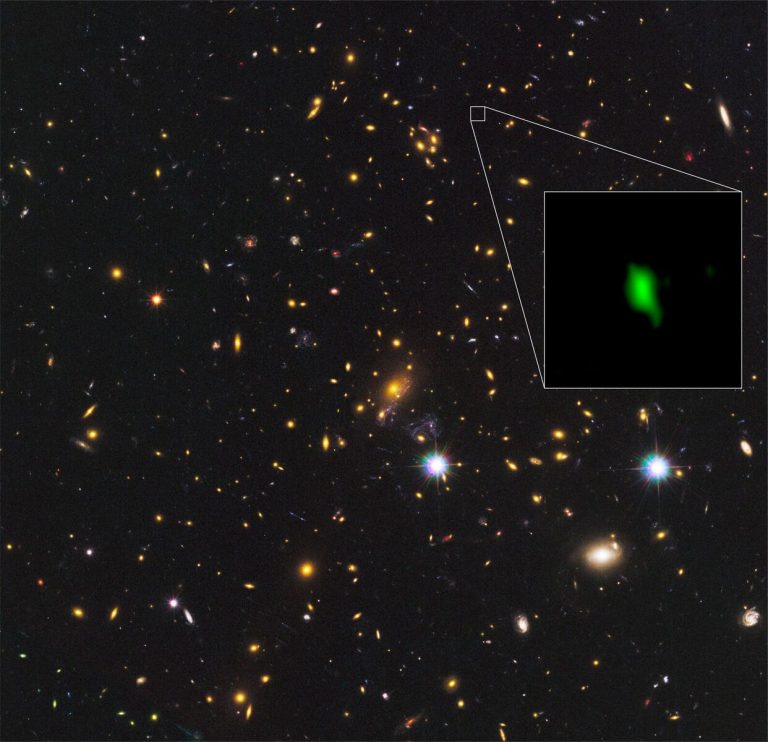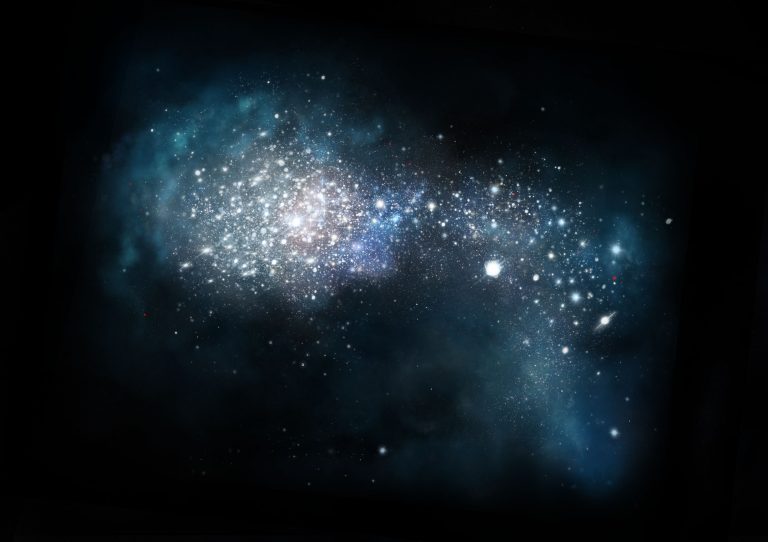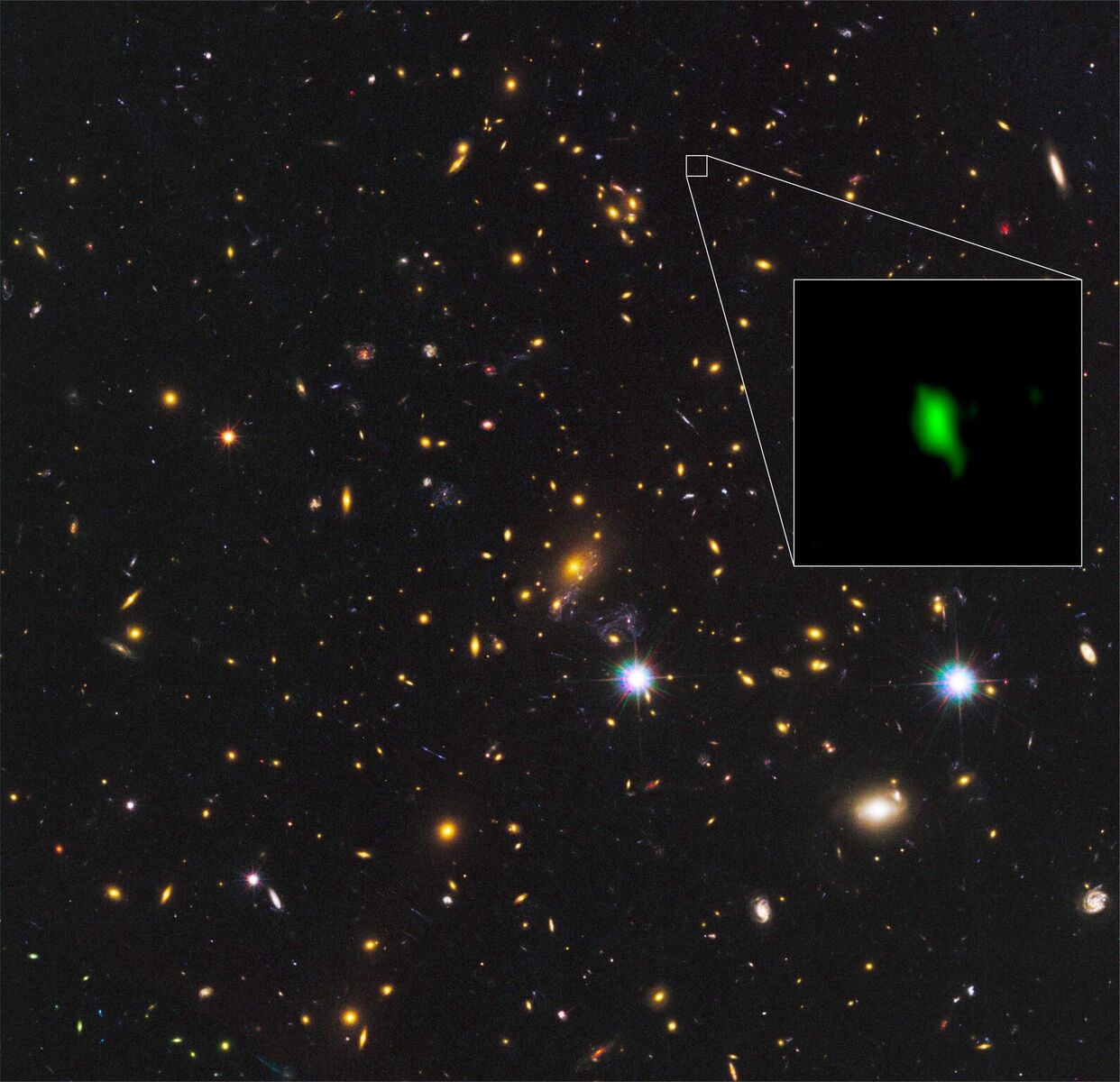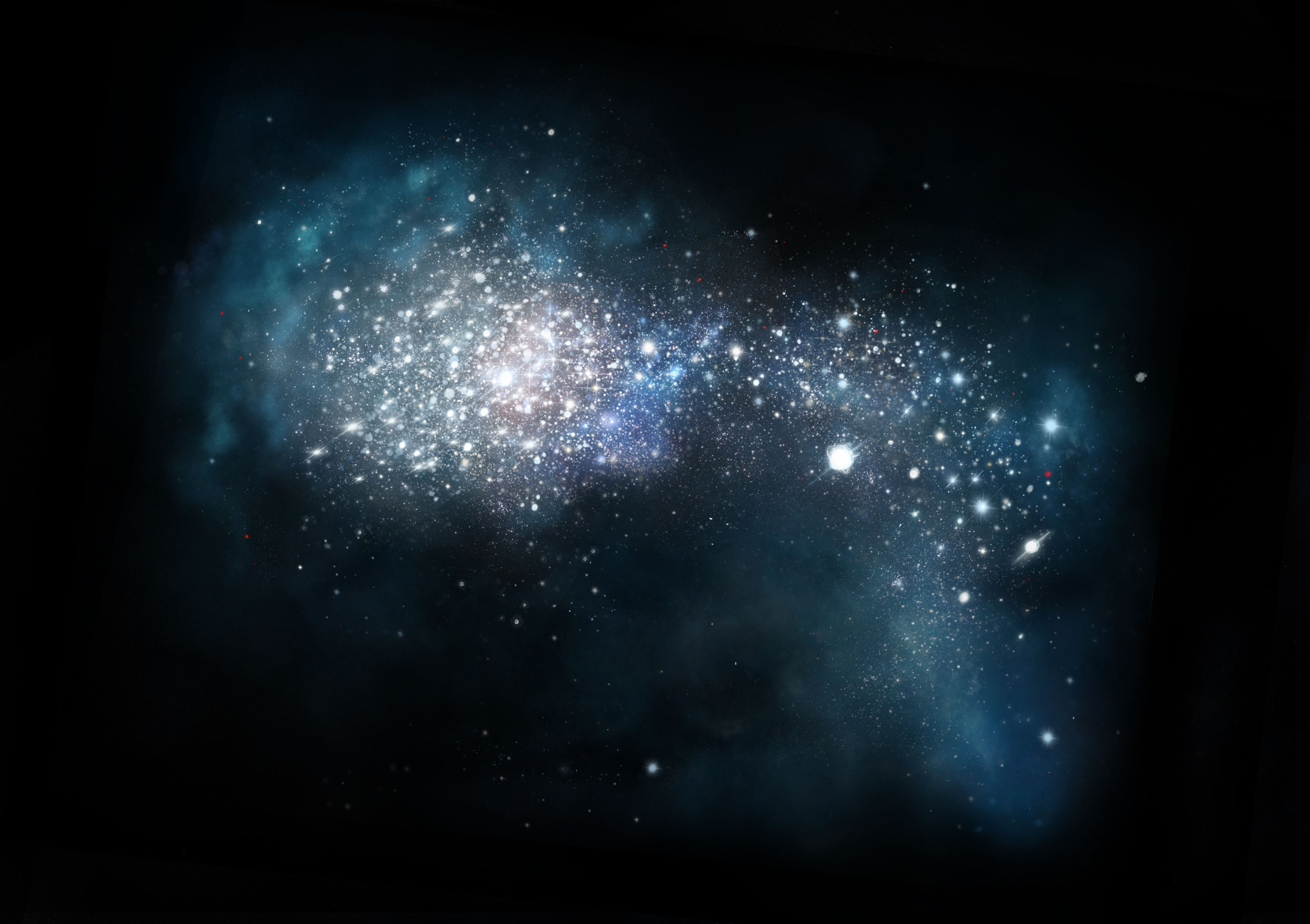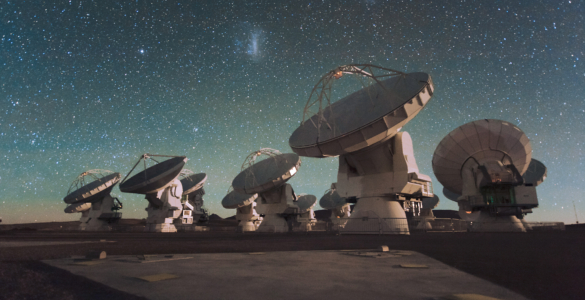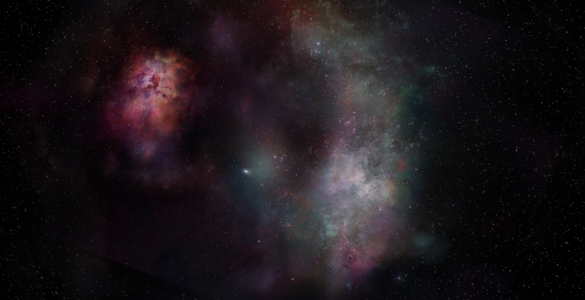Not long after the Big BangBig BangThe well-supported theory that some 13.8 billion years ago, the entire universe was staggeringly small, hot, and dense. In a fraction of an instant, the universe expanded and continues to expand to this day. , the first generations of stars began altering the chemical make-up of primitive galaxies, slowly enriching the interstellar mediumInterstellar mediumThe matter contained in the regions between star systems in a galaxy. This matter is typically made up of gas, dust, and cosmic rays. with basic elements such as oxygen, carbon, and nitrogen. Finding the earliest traces of these common elements would shed important light on the chemical evolution of galaxies, including our own.
New observations with the Atacama Large Millimeter/submillimeter Array (ALMA)Atacama Large Millimeter/submillimeter Array (ALMA)Funded by the U.S. National Science Foundation and its international partners (NRAO/ESO/NAOJ), ALMA is among the most complex and powerful astronomical observatories on Earth or in space. The telescope is an array of 66 high-precision dish antennas in northern Chile. reveal the faint, telltale signature of oxygen coming from a galaxy at a record-setting distance of 13.28 billion light-yearsLight-yearsThe distance that light travels in one year in a vacuum. One light year is equivalent to about six trillion miles. from Earth, meaning we are observing this object it as it appeared when the universe was only 500 million years old, or less than 4 percent its current age.
For such a young galaxy, known as MACS1149-JD1, to contain detectable traces of oxygen, it must have begun forging stars even earlier: a scant 250 million years after the Big Bang. This is exceptionally early in the history of the universe and suggests that rich chemical environments evolved quickly.
“I was thrilled to see the signal of the most distant oxygen,” explains Takuya Hashimoto, the lead author of the research paper published in the journal Nature and a researcher at Osaka Sangyo University and the National Astronomical Observatory of Japan.
“This extremely distant, extremely young galaxy has a remarkable chemical maturity to it,” said Wei Zheng, an astronomer at Johns Hopkins University in Baltimore, who led the discovery of this galaxy with the Hubble Space Telescope and estimated its distance. He also is a member of the ALMA research team. “It is truly remarkable that ALMA detected an emission lineEmission LineA bright line in a spectrum caused by the emission of photons from atoms. Astronomers use radio telescopes to identify specific emission lines to detect specific chemical and molecules throughout the cosmos. – the fingerprint of a particular element – at such a record-breaking distance.”
Following the Big Bang, the chemical composition of the universe was starkly limited, with not even a trace of elements like oxygen. It would take several generations of star birth and supernovasSupernovaThe extremely violent explosion of a star many times more massive than our Sun after the nuclear furnace at its core can no longer balance out the force of gravity. During this explosion, these stars may become as bright as all the other stars in a galaxy combined, and in which a great deal of matter is thrown off into space at high velocity and high energy. The remnant of these massive stars collapse into either a neutron star or a black hole. to seed the young cosmos with detectable amounts of oxygen, carbon, and other elements forged in the hearts of stars.
After they were liberated from their stellar furnaces by supernovas, these oxygen atoms made their way into interstellar space. There they became superheated and were ionizedIonized gasGas either between the stars or among galaxies that has been superheated so that electrons are stripped away from their atoms or molecules. by the light and radiation from massive stars. These hot, ionized atoms then “glowed” brightly in infrared light. As this light traveled the vast cosmic distances to Earth, it became stretched by the expansion of the universe, eventually becoming the distinct millimeter-wavelength light that ALMA is specifically designed to detect and study.
By measuring the precise change in the wavelength of this light – from infrared to millimeter – the team determined that this telltale signal of oxygen traveled 13.28 billion light-years to reach us, making it the most distant signature of oxygen ever detected by any telescope. This distance estimate was further confirmed by observations of neutral hydrogen in the galaxy by the European Southern Observatory’s Very Large Telescope. These observations independently verify that MACS1149-JD1 is the most distant galaxy with a precise distance measurement.
The team then reconstructed the star formation history in the galaxy using infrared data taken with the NASA/ESA Hubble Space Telescope and NASA’s Spitzer Space Telescope. The observed brightness of the galaxy is well explained by a model where the onset of star formation was another 250 million years ago. The model indicates that the star formation became inactive after the first stars ignited. It was then revived at the epoch of the ALMA observations: 500 million years after the Big Bang.
The astronomers suggest that the first burst of star formation blew the gas away from the galaxy, which would suppress the star formation for a time. The gas then fell back into the galaxy leading to the second burst of star formation. The massive newborn stars in the second burst ionized the oxygen between the stars; it is those emissions that have been detected with ALMA.
“The mature stellar population in MACS1149-JD1 implies that stars were forming back to even earlier times, beyond what we can currently see with our telescopes. This has very exciting implications for finding ‘cosmic dawn’ when the first galaxies emerged,” adds Nicolas Laporte, a researcher at University College London/Université de Toulouse and a member of the research team.
“I am sure that the future combination of ALMA and the James Webb Space Telescope will play an even greater role in our exploration of the first generation of stars and galaxies,” said Zheng.
ALMA has set the record for the most distant oxygen several times. In 2016, Akio Inoue at Osaka Sangyo University and his colleagues found the signal of oxygen at 13.1 billion light-years away with ALMA. Several months later, Nicolas Laporte of University College London used ALMA to detect oxygen at 13.2 billion light-years away. Now, the two teams merged into one and achieved this new record. This reflects both the competitive and collaborative nature of forefront of scientific research.
“With this discovery we managed to reach the earliest phase of cosmic star formation history,” said Hashimoto. “We are eager to find oxygen in even farther parts of the universe and expand the horizon of human knowledge.”
The National Radio Astronomy Observatory is a facility of the National Science Foundation, operated under cooperative agreement by Associated Universities, Inc.
# # #
Contact:
Charles Blue, Public Information Officer
(434) 296-0314; cblue@nrao.edu
Paper and research team:
These observation results are published in a paper titled “The onset of star formation 250 million years after the Big Bang” by T. Hashimoto et al. in the journal Nature.
The research team members are:
Takuya Hashimoto (Osaka Sangyo University/National Astronomical Observatory of Japan), Nicolas Laporte (University College London/Université de Toulouse), Ken Mawatari (Osaka Sangyo University/The University of Tokyo), Richard S. Ellis (University College London), Akio. K. Inoue (Osaka Sangyo University), Erik Zackrisson (Uppsala University), Guido Roberts-Borsani (University College London), Wei Zheng (Johns Hopkins University), Yoichi Tamura (Nagoya University), Franz E. Bauer (Pontificia Universidad Católica de Chile/Millennium Institute of Astrophysics/Space Science Institute), Thomas Fletcher (University College London), Yuichi Harikane (The University of Tokyo), Bunyo Hatsukade (The University of Tokyo), Natsuki H. Hayatsu (The University of Tokyo/European Southern Observatory), Yuichi Matsuda (National Astronomical Observatory of Japan/SOKENDAI), Hiroshi Matsuo (National Astronomical Observatory of Japan/SOKENDAI), Takashi Okamoto (Hokkaido University), Masami Ouchi (The University of Tokyo), Roser Pelló (Université de Toulouse), Claes-Erik Rydberg (Universität Heidelberg), Ikkoh Shimizu (Osaka University), Yoshiaki Taniguchi (The Open University of Japan), Hideki Umehata (The Open University of Japan/The University of Tokyo/RIKEN), Naoki Yoshida (The University of Tokyo)
The Atacama Large Millimeter/submillimeter Array (ALMA), an international astronomy facility, is a partnership of the European Organisation for Astronomical Research in the Southern Hemisphere (ESO), the U.S. National Science Foundation (NSF) and the National Institutes of Natural Sciences (NINS) of Japan in cooperation with the Republic of Chile. ALMA is funded by ESO on behalf of its Member States, by NSF in cooperation with the National Research Council of Canada (NRC) and the National Science Council of Taiwan (NSC) and by NINS in cooperation with the Academia Sinica (AS) in Taiwan and the Korea Astronomy and Space Science Institute (KASI).
ALMA construction and operations are led by ESO on behalf of its Member States; by the National Radio Astronomy Observatory (NRAO), managed by Associated Universities, Inc. (AUI), on behalf of North America; and by the National Astronomical Observatory of Japan (NAOJ) on behalf of East Asia. The Joint ALMA Observatory (JAO) provides the unified leadership and management of the construction, commissioning and operation of ALMA






